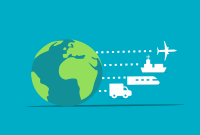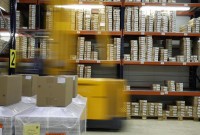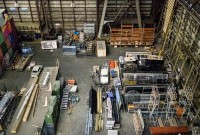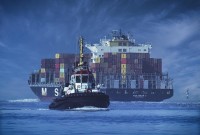- Home
- Business Processes
- Industry Knowledge
- Aerospace Industry
- Automotive Industry
- Banking Domain
- BFSI Industry
- Consumer/ FMCG Industry
- Chemicals Industry
- Engineering & Construction
- Energy Industry
- Education Domain
- Finance Domain
- Hospitality Domain
- Healthcare Industry
- Insurance Domain
- Retail Industry
- Travel and Tourism Domain
- Telecom Industry
- Leadership Skills
- eLearning
- Home
- Business Processes
- Warehouse Management
- Outbound Shipment Process
Outbound Shipment Process
The Outbound process starts with routing the shipments. The Outbound execution process starts from the point when pick tasks are completed for an outbound shipment and ends at the point where the outbound packages are loaded into trailers. The Warehouse Outbound process includes managing and controlling outgoing materials starting from the download of orders through to the shipping of products from the warehouse.
The Outbound process starts with routing the shipments. The Outbound execution process starts from the point when pick tasks are completed for an outbound shipment and ends at the point where the outbound packages are loaded into trailers. The Warehouse Outbound process includes managing and controlling outgoing materials starting from the download of orders through to the shipping of products from the warehouse. One has many ways to ship a product from one place to another. The mode of transportation determines the way goods need to be prepared for shipment, including getting the paperwork and labeling correct.
Seamless and flawless execution of this process is an integral part of how reduced order turnaround time and inventory accuracy is achieved. The ability of a system to mirror the routing of inventory in order to comply with the customer and item requirements are key to reducing turnaround time.
Outbound Shipping Process
Various steps in outbound shipment process are explained below:
Outbound Order
The outbound process begins when a sales order, production order or Kanban order is created to release the item from the inventory. The paperwork for shipping a domestic package via a parcel carrier is very different from the paperwork for shipping internationally on a container ship. Some products, such as alcohol and tobacco, require special licenses or permits. Other products are subject to trade restrictions when they’re shipped to another country. Also, some products are hazardous and may not be accepted by a particular carrier.
Order Download
Getting all shipping details right is critical for the shipping process and it requires communication among the seller, the buyer, and each carrier that handles the freight while it’s in transit. In the best cases, mistakes and miscommunications can cause delays that prevent products from reaching customers quickly and safely. Warehouse need to download the release to start the outbound process.
Release
The release of goods is the main task of the warehouse staff. Releases are based on orders transferred from the business/store. A release order, in other words the order completion request, contains information about the goods to be released (which products and what quantities) and the address to which the goods need to be shipped. The ordering person submits the goods release order to the warehouse. Every goods release order (release procedure) shall contain description and quantity of goods to be released and release method descriptions (personal receipt, shipping etc.)
Create a Batch
Batch defines multiple tasks across shipments in one trip. Equipment in warehouse has constraints that limit the number of units that could be picked in one trip due to available slots in carts or physical limitations. Batch building helps in defining the items and quantity that needs to be packed, the size of carton and locations for pick. The optimal batch is determined by calculating cost of picking using criteria including number of trips, number of locations visited and the number of aisles to be visited, to determine the batch that takes the least time. Once the batch has been finalized, the consolidated Batch Sheet and container labels are printed for all shipments in the release. The supervisor hands over the Batch Sheet and container labels to the user.
Containerization
Process Containerization is the process of using standardized containers for the storage and transport of loose units from a warehouse. This process helps to determine the pick and pack strategy. This process considers various constraints like physical characteristics of the containers, specific type and size of packaging, fill percentages, rules for mixing inventory and other packing strategies to create the optimum picking and packing strategy. Containerization process provides an overview of the quantity and types of containers that are going to be used for packing prior to the picking of goods, and determine quantities that will fit into the containers. This allows the warehouse workers to pick the items directly into the chosen container.
Picking Process
Order picking is the process of selecting items from a warehouse , to fulfill customer orders. Picking tasks are executed using the Mobile Application, batch sheets, or Material Handling Equipment (MHE). During picking, additional attributes, such as serial numbers could be captured. If the quantity to pick is equal to the case quantity, the user picks the container and affixes the label. If the quantity to pick is greater than the case quantity, the user picks an empty container that can accommodate the quantity specified in the label. The user then places the appropriate quantity into the container and affixes the label to the container. The user deposits the inventory at the appropriate location (usually the Pack Station).
Packaging Process
When the container is completely packed, the user manually closes the container. On closing each container, the shipping label for the particular container gets printed. The user completes the pack process of the case by scanning the container at the Confirm Carton Pack Complete station. Upon closing and confirming the last container of the shipment, the packing slip gets printed.
Pack and Hold Process
Orders to be shipped in the future can be packed in advance. For example, during certain seasons, orders may be placed in bulk. In such cases, the shipments are picked and packed in advance to avoid overload on the actual shipping day. Shipments that are packed and stored away to be retrieved on the actual shipping day are known as Pack and Hold shipments. A move request is created to move the shipment from the Pack Station or Weigh Station to a designated Pack and Hold location.
Pallet Shrink Wrap Process
The pallet is brought to the Pallet Shrink Wrap station and then it is wrapped and required dunnage material is added, if any. On shrink wrapping the pallet, the container or shipping label is printed and affixed on the container. The user deposits the inventory at the appropriate location (usually the Manifest station).
Sorting Process
Once the weight has been captured, the case/pallet is manually moved to the shipment sorter location, where the pallet is sorted based on the shipment. At the shipment sorter location, the inventory is sorted by shipment and shipped out in the appropriate carrier.
Load Rollover Process
Because of new or changing circumstances, when all planned loads could not be picked or the full load doesn't fit onto a single truck, or where some of the load should leave the warehouse before the rest of the load is ready for shipment. In these scenarios, the user can either split the remaining quantities onto a new load or to cancel the incomplete quantities. In case of rollover, remaining load lines (including full or partial line quantities) are then rolled over to a newly created load and shipment.
Electronic Shipper’s Export Declaration Process
Any shipper shipping international shipments from the United States of America needs to file an electronic shipper’s export declaration (SED) for Schedule B items with a value greater than $2500. The electronic SED filed is used for compiling the official U.S. export statistics and for export control. The shipments or loads included in an SED are kept on hold for filing the SED. The shipper submits the electronic SED to AES Direct using the AES Direct Web Link or through Electronic Data Interchange (EDI). After filing the SED through AES, the shipper gets the ITN. For shipments, ITN should be either stamped or manually entered on the Load Bill Of Lading (BOL).
Print Load BOL
A bill of lading (BL or BoL) is a legal document issued by a carrier to a shipper that details the type, quantity and destination of the goods being carried. When the load is confirmed, then Bill of Lading (BOL) of the load is generated.
Shipping from Warehouse
The final step is to send ship loads out of the warehouse once all the work that is associated with those loads has been completed. Based on the delivery options and shipping services you offer to customers, shipping carriers or your transportation agents (Example: DHL, USPS, FedEx and UPS etc.) will pick up orders from the warehouse to ship packages to their next destination. Once the order ships, you need to generate order tracking information back to your store so your customers can track their shipments.
Replenishment Process
In a warehouse, as a product is removed from the Forward Pick Area, the inventory in that location requires re-stocking. This process is called Replenishment. During this process the inventory is identified at the source location, the user picks the suggested inventory from source location and brings it to deposit location. Inventory levels are periodically checked and replenishment is done based on inventory levels. One option is to replenish when net inventory at a location falls below the minimum level. Other option is to replenish when the net inventory at a location falls below the maximum level. Task priority will be high in case of first option to replenish, compared to second option.
Related Links
You May Also Like
-
Business Case of Multiple Warehouses
Adding extra warehouses to business provides many benefits such as reducing shipping costs, increasing storage capacity, and having warehouses for specific purposes to simplify overall warehouse management. Multiple warehouses allow you to organize your inventory in a way that helps your business be more effective.
-
In the normal course of business, customers are likely to return orders from time to time due to various reasons and business should design processes the manage and accept such returns. A well designed returns management process can reduce costs and issues associated with returns or exchanges.
-
Warehouses may seem like a simple, straightforward concept, but they actually include a variety of different types of warehouses that all have their own niche. The type of warehousing that’s right for you depends on your specific industry, location, and needs. From private warehousing, distribution centers, and climate-controlled warehouses, there’s an option to suit every business.
-
Types of Inventory Count Processes
While dealing with lots of inventory in a warehouse, lots of things can go wrong. Shipments may not have the right number of units in them, or they could get damaged somewhere along the supply chain. Discrepancies in the stock may arise as part of every inventory control, and need to be corrected immediately after the inventory control procedure has been finished.
-
One of the most important decisions when running a warehouse is its layout. Warehouse layout defines the physical arrangement of storage racks, loading and unloading areas, equipment and other facility areas in the warehouse. A good layout aligned with the business needs could have a significant effect on the efficiency.
-
Warehouse management and distribution logistics involve the physical warehouse where products are stored, as well as the receipt and movement of goods takes place. Warehouse management aims to control the storage and movement of products and materials within a warehouse. These operations include the receipting of inwards goods, tracking, stacking and stock movement through the warehouse.
-
The Outbound process starts with routing the shipments. The Outbound execution process starts from the point when pick tasks are completed for an outbound shipment and ends at the point where the outbound packages are loaded into trailers. The Warehouse Outbound process includes managing and controlling outgoing materials starting from the download of orders through to the shipping of products from the warehouse.
-
Overview of Warehouse Processes
The basic function of a warehouse is to store goods. This means that they receive deliveries from suppliers, do any necessary checking and sorting, store the materials until it is dispatched to customers. Traditionally warehouses were seen as places for the long-term storage of goods. Now organizations want to optimize their customer experience and try to move materials quickly through the supply chain, so the role of warehousing has changed.
-
Miscellaneous Warehouse Processes
At the end of each inventory control, the Contractor provides the Ordering Person with an inventory report which contains a list of all stock adjustments. The Ordering Person uses the report to create, by use of his/her own means, necessary value and accounting adjustments related to the stock. Let us look at some to the mislaneous warehouse processes not covered earlier.
-
After products have been received and passed a quality inspection, they need to be stored so that you can find them when you need them. This process is called putaway. The spot where you store a particular product is called a location. One section of a warehouse might have small locations for light items; another area may have large locations on the floor for heavy items.
Explore Our Free Training Articles or
Sign Up to Start With Our eLearning Courses

About Us
Learning
© 2023 TechnoFunc, All Rights Reserved











